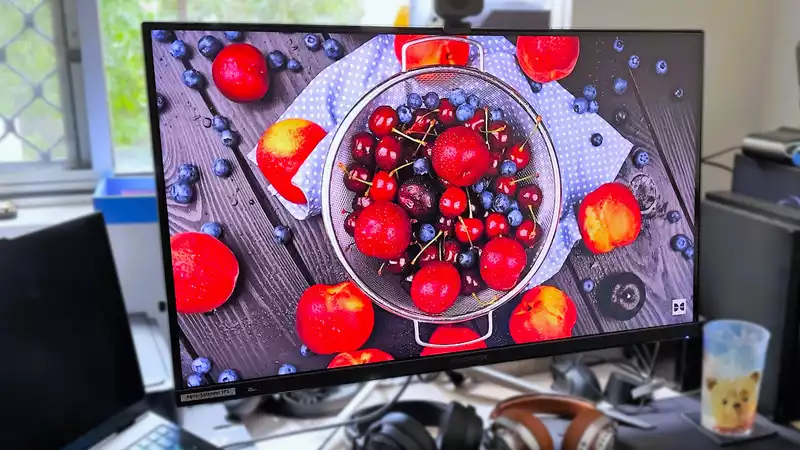In my opinion, a gaming monitor should be QD-OLED or Mini LED. Both offer excellent color, contrast, and HDR performance, which to me is far more important than the ridiculous 500Hz refresh rate. Both have their pros and cons, with the OLED having better contrast and response, and the Mini LED being brighter but with more blooming. But after checking out the Acer Predator X32 FP Mini LED, I am seriously leaning toward the latter.
The Predator X32 FP has a crisp 4K resolution, plenty of ports, HDR 1,000, and 576 local dimming zones. This is quite impressive for a 32-inch screen, but still about half the number found on the Samsung Odyssey Neo G8. But both monitors cost the same $1,500/£1,390. That's quite an expense.
I noticed more blooming on the X32 FP than on the G8 - a distracting glow or fog around a bright object on a dark background; in the X32's dark mode, the cursor gives off a slight glow, and the dimming zone often turns on and off as it moves. It wasn't enough to be a problem, and in most games it didn't bother me much.
So why is this Acer monitor worth the same price as the Neo G8? Certainly, image quality has something to do with it. Its Agile Splendour IPS panel has all kinds of protectors for the eyes, but manages to maintain a 99% Adobe RGB, 10-bit wide color gamut with Delta E<1. As a content creator and designer, I can appreciate the benefit of a monitor that I can also use for professional work but also get lost in the glorious world of Elden Ring.
Most monitors in the Windows desktop environment alone, HDR is often not available, but it can wash out colors, make white pages too bright to see, and make reading text very difficult. In fact, I love the HDR mode on the X32 FP. This is where this monitor excels. [With a peak brightness of 1,200 nits, the X32 FP is VESA DisplayHDR 1000 certified and is without a doubt one of the best HDR gaming monitors I have ever experienced.
I've been playing a lot of "Atomic Heart" and "Wo Long" and both are stunning showcases, super bright outdoors and dark and dim indoors, and the X32 delivers a gorgeous view all around, with excellent detail in dark areas and plenty of bright highlights.
As if this wasn't enough, it delivers all this at a pin-sharp 3840 x 2160 resolution, smooth, 0.7ms GtG response, and 160Hz refresh rate. Again, it's not as fast as the Neo G8's 240Hz, but it's more than most non-sports professionals need.
The X32 supports AMD FreeSync Premium Pro, but despite not recognizing the monitor as G-Sync compatible, I had no problems running it on my RTX 3080. Additionally, the monitor supports VRR, which combined with four HDMI 2.1 ports makes it ideal for PlayStation 5 and Xbox Series X|S owners; for Steam Deck (open in new tab) owners, the USB Type-C downstream provides 90W, making it easy to charge the Deck.
Speaking of ports, the X32 thrills me with its abundance of ports: in addition to an HDMI 2.1 port, there is a DisplayPort 1.4 and a 90W PD USB Type-C video input. Even better are the four USB 3.0 ports, two of which are located on the left side of the monitor for easy access.
The X32 has a KVM switch that brings all these ports together. This allows you to use peripherals connected to the X32 and swap between connected PCs. This is especially useful for those who have a gaming PC and a laptop for work. To use this feature, both PCs must be connected via USB Type-C and Type-B ports, and the monitor can switch between them automatically. A nice addition, but a rather niche use case.
There is not much to say about the physical design. Acer stuck to the aesthetics of the decades-old Predator. Anyway, most of the time is spent on the screen and not looking at the unit. The stand has a fairly deep stance thanks to the two metal feet, which I appreciate. It is very solid and I don't notice any wobble. Height, swivel, and tilt can be adjusted smoothly. However, it cannot be rotated.
The main OSD is standard gaming stuff, with rows of buttons and joysticks on the back of the monitor; there are 6-axis color controls and numerous preset color modes, but I found the default HDR mode to be sufficient.
The Acer Predator X32 FP is one of my favorite Mini LED gaming monitors, and I highly recommend it if you are a pro Mini LED team. However, the suggested price of $1,500/£1,390 is high.
Now you can get the best gaming monitor, the Philips Evnia 34M2C8600 (opens in new tab), for $200 less. Given that this OLED monitor meets all of the above points and handles HDR shockingly well, it's hard to recommend a monitor that is 2 inches smaller, has a slower response time, and a lower refresh rate for more cash. [But that doesn't change the fact that the X32 FP is a great monitor.
.

Comments